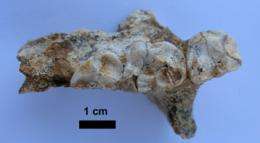New extinct lemur species discovered in Madagascar

A third species of Palaeopropithecus, an extinct group of large lemurs, has just been uncovered in the northwest of Madagascar by a Franco-Madagascan team.
Baptised Palaeopropithecus kelyus, this new specimen is smaller than the two species of these 'large sloth lemurs' already known and its diet made up of harder-textured foodstuffs. This discovery supports the idea of a richer biodiversity in recent prehistory (late Pleistocene and beginning of the Holocene). The results, currently available online, will be published in the Comptes Rendus de l'Académie des Sciences Palevol, July-August 2009.
Madagascar, where natural environments show a high level of endemism, is one of the last great biodiversity sanctuaries in the world. The island is home to a special group of primates, the lemurs. There are presently 15 genera and 71 species of these small mammals on Madagascar.
The genus Palaeopropithecus is a group of subfossil giant lemurs. Up until now, two species had been described: P. ingens (in 1898) and P. maximus (in 1903). Palaeopropithecus have very specific adaptations, notably for locomotion, as they moved from branch to branch using all four limbs, with their head downwards, in a similar way to today's South American sloths.
Recent discoveries by the MAPPM on sites in northwest Madagascar have established the existence of a third species of Palaeopropithecus, which has been baptised P. kelyus. Scientists have suspected the existence of this species for more than 20 years. P. kelyus, whose weight is estimated around 35 kg, is smaller than the two known Palaeopropithecus species, but is very large in comparison with the largest living lemur, the Indri, which weighs only 10 kg.
The other main difference of this new species is that its teeth are smaller. Its dental characteristics could be described from the P. kelyus subfossil maxilla fragment, showing a crista obliqua, a parastyle and a highly developed mesostyle. This morphology is reminiscent of the present day Propithecus genus. While other Palaeopropithecus must have fed on leaves and fruit, the differences in the teeth of P. kelyus suggest that this animal could chew much tougher foods (notably seeds) compared with the other two known species. P. kelyus was found in an area of northwest Madagascar (Boeny region, Mahajanga province) with the particularity of being situated between large bays and rivers. This topography could have isolated P. kelyus from the other two species of Palaeopropithecus, one of which lived more in the south or centre, and the other in the north of Madagascar.
In the 'evolution laboratory' that Madagascar represents, the discovery of this third Palaeopropithecus contributes to our understanding of the subfossil fauna species. More broadly, such work also includes the study of the island's human population.
More information: D.Gommery et al., C.R. Palevol, vol 8 (5), July-August 2009 © 2009 Académie des sciences / Elsevier Masson (DOI : 10.1016/j.crpv.2009.02.001) www.em-consulte.com/revue/palevo/s200/4901
Provided by CNRS, France

















